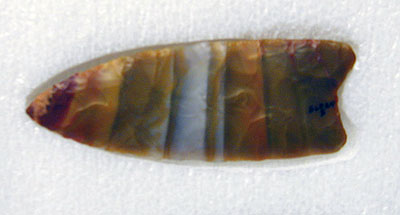Wednesday, July 1, 2009
The Europeans discovered Canada 28.000 years ago
A fact which sends the multi-cult, European civilisation-hating elite, into a terrible frenzy.
by StFerdIII


It is hard to celebrate a national holiday or the birth of a wealthy prosperous nation if you don't know anything about it. Few Canadians know when, how, why what, or who created their state. Few know or appreciate that the Canadian state can trace its origins back one thousand years to the gestation's of freedom embedded in Norman, Briton and Anglo-Saxon practices and culture – themselves tied to the ancient legacies embodied by Charlemagne, Alfred, the Romans and the Greeks. But one inconvenient truth which is never discussed within polite circles is the myth that Asians first discovered Canada and North America. They didn't.
Such a truth would completely upend much of the multi-cult, blame-whitey, hate modernity-industry which now exists across wide swathes of the political-economy. Even to propose such a heresy will immediately imply someone as a racist. But it is a fact which is slowly coming out. Europeans crossed a land bridge circa 28.000 B.C, during the last ice age over a period most likely of 15.000 years and discovered North America – some 18.000 years before a similar ice or land bridge opened up between Alaska and Asia allowing Asian clans to migrate to find game and living space in North America.
The facts supporting the European discovery of North America are quite strong. To its credit some years back the Discovery channel fashioned a short documentary on this migration, though a copy of it in DVD or video format is hard if not impossible to find. This documentary summarizes much of the factual evidence supporting the claim that nomadic Europeans, outcasts and those searching for large sources of fresh meat such as seals or Mastodons, traversed a wide arching ice bridge which stretched from southern France to the mid-Atlantic US states. These sojourners discovered America most likely on foot, but also quite possibly by boat.
Spear points found In Virginia and elsewhere dating back to 28.000 B.C. tie North America to Europe. In North America the demise of all the largest mammals including Mastodons, large buffalo, tigers, lions and the massive short face bear, is usually attributed to humans hunting in well organized parties, using advanced flint and stone weapons and especially what is called the 'Clovis' spear point – a highly engineered flint tip which can pierce the toughest hides. Long thought to be created in North America, the Clovis spear point in actual fact resembles exactly the same spear points found in France and Spain called the Solutrean spear point.
The two spear points are not just similar, they are exact replicas. This implies of course that the flint knapping technology and skill was carried from Europe to America. Clovis and Solutrean points have never been discovered in Asia. Most of the Clovis points in North America are to be found in the eastern part of the Continent, though other areas are now being discovered which also contain Clovis fragments. This would make sense since the original European explorers would have hunted and created their communities along the giant ice wall which dominated the eastern landscape of North America down to Virginia. Along this wall of ice would have been grasslands teeming with large game. There would have been little reason to migrate – at least initially – to other areas of North America until millenia after the discovery of the Continent.
Another link to Europeans as the first discoverers of North America is DNA. Genes within DNA are data banks of information extending back to the first humans. American Indian DNA has large traces of European genes. It means that Asian and European peoples at one time co-mingled and inter-bred in North America. The Europeans arrived about 28.000 BC and most likely over 18.000 years there was much traffic as thousands of humans traversed back and forth from Europe to North America.
Around 10.000 B.C another ice bridge in the West from Asia allowed Asiatic clans to imitate the European migration into a new Continent in search of food, better living conditions and more nomadic living space. At some point the two groups would have faced each other. No one knows the results, but the existence of European DNA in Indian tribes as diverse as the Ojibwa of Central Canada, and the Cherokee of Florida, indicates that a cross-fertilization of humans took place.
It has been proven for example that a unique DNA haplogroup marker found in some American Indian DNA must have come from the only other place it is found, namely Europe. Haplogroup DNA is 17,000 years old. The American Association for the Advancement of Science is studying DNA in 'power packs' of cells called mitochondira which can help elucidate and compare populations to analyze migratory patterns. Mitochondria analysis also reveals that up to ¼ of North American Indian DNA is European based.
Even the oldest skull in North America - found near Mexico City, named Peñon woman and dated from 11.000 BC is Caucasian. "Research team leader Dr. Silvia Gonzalez believes that Peñon woman does in fact prove the Solutrean hypothesis. “At the moment it points to that as being likely. They were definitely not Mongoloid in appearance. They were from somewhere else. As to whether they were European, at this point in time we cannot say ‘no’,” Dr Gonzalez said." Caucasian skulls and bones pre-dating Asian tribal arrival have been discovered even in Western North America - much to the disgust and fury of 'Native' Indians. Yet many more such discoveries - far older in fact - await to be found.
The only argument against the connection between Solutrean and Clovis civilisations is that the journey would have been too long and too difficult. But this is not true. The land bridge would have been a 3.000 km journey – similar to what Asian tribes from Japan, Manchuria and Siberia, undertook circa 10.000 B.C.
Solutrean civilisation which existed circa 20.000 B.C., in their use of natural resources, hunting, technology and social skills was at least and quite probably a lot more advanced than those of the migrating Asians some 10.000 years later. We can see this from archeological finds in France and Spain.
Solutrean 'cave dwellers' were nothing of the type. They had a sophisticated and rather advanced stone age society utilizing some astonishing technologies and skill in the shaping of tools, implements, weapons and even social structures. They were not brutes. There is even evidence that Solutreans and their ancestors were adept with seal skin boats, and one theory is that some Europeans made the migration to North America in such vessels - proven to be durable in ocean waters. If this is true it would cut the time of the migration down to a matter of a few months. This is certainly something a fit, determined and motivated clan could and would accomplish.
It is also rather hard to believe that a group of people with method, motive and prowess such as Solutrean or their ancestors, could not have made the same journey, in probably less harsh conditions, than their Asian counterparts. Of course if you were to say the opposite you would be labeled a racist. At the very least this most likely of occurrences – a European migration circa 28.000 B.C. to North America - which lasted for millenia needs to be discussed, investigated and analysed. That is what is called science and that is what informs real education.
In any event it makes Canada Day more interesting.